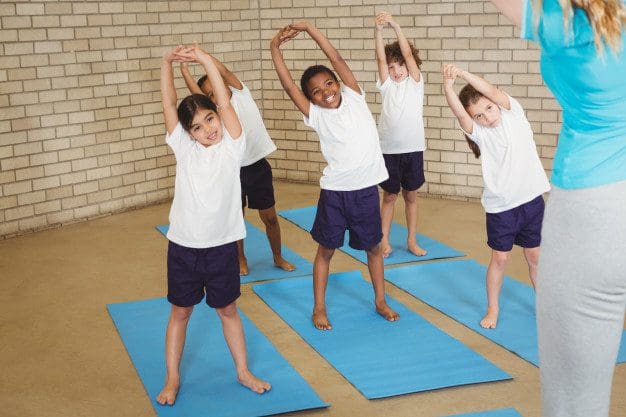Table of Contents
Strength Training

- Controlled movements
- Proper technique
- Correct form
- Uses more repetitions
- Uses lighter weights.
- Free weights
- Weight machines
- Resistance bands
- A child’s own body weight
- Build strength
- Improve muscle coordination
- Enhance long-term health
- Rehabilitate injuries
- Prevent injuries

Training Guidelines
It is fundamental to find a program that is safe and successful for children. Parents want a program that is designed specifically for kids, is supervised by a fitness professional with child experience, and most of all that it is fun. For strength training there is not a minimum age, however, the kids should be able to understand and follow directions. Before starting a child on any new fitness program check with their doctor or healthcare provider.A training program should include:
- A session should start with a 5-10 minute warm-up exercise/s like stretching and light aerobics.
- Every session should end with a cool-down combined with stretching and relaxation.
- Kids should not immediately be using weights until proper form and technique are learned.
- Kids should start with their own body weight, bands, or a bar with no weight.
- Using 6-8 different exercises that address all the muscle groups, begin with 8-15 repetitions.
- Each exercise should be done with a complete follow-through of the full range of motion.
- If the repetitions are too much with a specific weight, reduce the weight.
- Repetitions and sets should gradually increase over time to maintain the intensity of the training.
- Add more weight only when the child displays the proper form and can easily do at least 10 reps.
- Workouts should be 20 to 30 minutes long, 2 to 3 times per week to get the most benefit.
- Make sure to rest a day between each workout day.

Safety
Strength training was not always considered appropriate exercise for kids. Doctors and fitness professionals believed that it was unsafe for a child’s growing body because of the added pressure on growth plates or the cartilage that has not fully turned into solid bone. Experts now know that with proper technique and supervision, kids can safely participate in a strength training program. As with any type of exercise/fitness regiment, safety measures need to be in place along with heightened supervision. Most injuries happen when kids are not supervised, not using proper techniques, or from trying to lift too much weight. Here are some safety precautions to remember:- Learning new exercises should be done under the supervision of a trainer/instructor making sure proper technique and form are used
- Smooth controlled motions should be the goal
- Controlled breathing and not holding their breath needs to be taught
- Proper technique will help avoid injuries
- The kids’ progress should be monitored
- Have the children keep a record of the exercises they have done, how many reps, and the amount of weight/resistance.
- If enrolled in a strength training class, a good ratio is one instructor per 10 students. With this ratio, the kids can receive proper instruction and supervision.
- Kids should train in a hazard-free, well-lit, and properly ventilated facility.
- Make sure the kids drink plenty of water during and after the workout
- Fitness trainers/instructors will see to it that there are frequent rest and rehydration breaks
Keep in mind
In a strength training program for children, there should be no competitive drive. The focus should be on participation, learning the movements, and positive reinforcement. Set realistic goals and expectations for the child, so that they understand that it will take time to learn these new skills. Remember that kids do not increase muscle size until after puberty. Make sure the kids enjoy the strength training sessions and that they are having fun. Keep in mind that kids can become easily bored. Therefore use a variety of exercises and routines keeping them excited and wanting to learn and do more.Healthy Habits
Getting kids interested in fitness early on can help establish a life-long habit of wanting to be and stay healthy. This includes a balanced diet, plenty of rest, and regular exercise. When done correctly strength training can be a fun and highly beneficial activity.PUSH Fitness
Dr. Alex Jimenez’s Blog Post Disclaimer
The scope of our information is limited to chiropractic, musculoskeletal, physical medicines, wellness, and sensitive health issues and/or functional medicine articles, topics, and discussions. We use functional health & wellness protocols to treat and support care for injuries or disorders of the musculoskeletal system. Our posts, topics, subjects, and insights cover clinical matters, issues, and topics that relate and support directly or indirectly our clinical scope of practice.* Our office has made a reasonable attempt to provide supportive citations and has identified the relevant research study or studies supporting our posts. We also make copies of supporting research studies available to the board and or the public upon request. We understand that we cover matters that require an additional explanation as to how it may assist in a particular care plan or treatment protocol; therefore, to further discuss the subject matter above, please feel free to ask Dr. Alex Jimenez or contact us at 915-850-0900. The provider(s) Licensed in Texas& New MexicoPost Disclaimer
Professional Scope of Practice *
The information herein on "Kids and Strength Training" is not intended to replace a one-on-one relationship with a qualified health care professional or licensed physician and is not medical advice. We encourage you to make healthcare decisions based on your research and partnership with a qualified healthcare professional.
Blog Information & Scope Discussions
Welcome to El Paso's Premier Wellness, Personal Injury Care Clinic & Wellness Blog, where Dr. Alex Jimenez, DC, FNP-C, a Multi-State board-certified Family Practice Nurse Practitioner (FNP-BC) and Chiropractor (DC), presents insights on how our multidisciplinary team is dedicated to holistic healing and personalized care. Our practice aligns with evidence-based treatment protocols inspired by integrative medicine principles, similar to those found on this site and our family practice-based chiromed.com site, focusing on restoring health naturally for patients of all ages.
Our areas of multidisciplinary practice include Wellness & Nutrition, Chronic Pain, Personal Injury, Auto Accident Care, Work Injuries, Back Injury, Low Back Pain, Neck Pain, Migraine Headaches, Sports Injuries, Severe Sciatica, Scoliosis, Complex Herniated Discs, Fibromyalgia, Chronic Pain, Complex Injuries, Stress Management, Functional Medicine Treatments, and in-scope care protocols.
Our information scope is multidisciplinary, focusing on musculoskeletal and physical medicine, wellness, contributing etiological viscerosomatic disturbances within clinical presentations, associated somato-visceral reflex clinical dynamics, subluxation complexes, sensitive health issues, and functional medicine articles, topics, and discussions.
We provide and present clinical collaboration with specialists from various disciplines. Each specialist is governed by their professional scope of practice and their jurisdiction of licensure. We use functional health & wellness protocols to treat and support care for musculoskeletal injuries or disorders.
Our videos, posts, topics, and insights address clinical matters and issues that are directly or indirectly related to our clinical scope of practice.
Our office has made a reasonable effort to provide supportive citations and has identified relevant research studies that support our posts. We provide copies of supporting research studies upon request to regulatory boards and the public.
We understand that we cover matters that require an additional explanation of how they may assist in a particular care plan or treatment protocol; therefore, to discuss the subject matter above further, please feel free to ask Dr. Alex Jimenez, DC, APRN, FNP-BC, or contact us at 915-850-0900.
We are here to help you and your family.
Blessings
Dr. Alex Jimenez DC, MSACP, APRN, FNP-BC*, CCST, IFMCP, CFMP, ATN
email: coach@elpasofunctionalmedicine.com
Multidisciplinary Licensing & Board Certifications:
Licensed as a Doctor of Chiropractic (DC) in Texas & New Mexico*
Texas DC License #: TX5807, Verified: TX5807
New Mexico DC License #: NM-DC2182, Verified: NM-DC2182
Multi-State Advanced Practice Registered Nurse (APRN*) in Texas & Multi-States
Multistate Compact APRN License by Endorsement (42 States)
Texas APRN License #: 1191402, Verified: 1191402 *
Florida APRN License #: 11043890, Verified: APRN11043890 *
License Verification Link: Nursys License Verifier
* Prescriptive Authority Authorized
ANCC FNP-BC: Board Certified Nurse Practitioner*
Compact Status: Multi-State License: Authorized to Practice in 40 States*
Graduate with Honors: ICHS: MSN-FNP (Family Nurse Practitioner Program)
Degree Granted. Master's in Family Practice MSN Diploma (Cum Laude)
Dr. Alex Jimenez, DC, APRN, FNP-BC*, CFMP, IFMCP, ATN, CCST
My Digital Business Card
RN: Registered Nurse
APRNP: Advanced Practice Registered Nurse
FNP: Family Practice Specialization
DC: Doctor of Chiropractic
CFMP: Certified Functional Medicine Provider
MSN-FNP: Master of Science in Family Practice Medicine
MSACP: Master of Science in Advanced Clinical Practice
IFMCP: Institute of Functional Medicine
CCST: Certified Chiropractic Spinal Trauma
ATN: Advanced Translational Neutrogenomics





 Again, We Welcome You.
Again, We Welcome You.
Comments are closed.